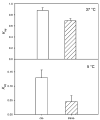Trans fatty acid derived phospholipids show increased membrane cholesterol and reduced receptor activation as compared to their cis analogs
- PMID: 15766276
- PMCID: PMC1779501
- DOI: 10.1021/bi048319+
Trans fatty acid derived phospholipids show increased membrane cholesterol and reduced receptor activation as compared to their cis analogs
Abstract
The consumption of trans fatty acid (TFA) is linked to the elevation of LDL cholesterol and is considered to be a major health risk factor for coronary heart disease. Despite several decades of extensive research on this subject, the underlying mechanism of how TFA modulates serum cholesterol levels remains elusive. In this study, we examined the molecular interaction of TFA-derived phospholipid with cholesterol and the membrane receptor rhodopsin in model membranes. Rhodopsin is a prototypical member of the G-protein coupled receptor family. It has a well-characterized structure and function and serves as a model membrane receptor in this study. Phospholipid-cholesterol affinity was quantified by measuring cholesterol partition coefficients. Phospholipid-receptor interactions were probed by measuring the level of rhodopsin activation. Our study shows that phospholipid derived from TFA had a higher membrane cholesterol affinity than their cis analogues. TFA phospholipid membranes also exhibited a higher acyl chain packing order, which was indicated by the lower acyl chain packing free volume as determined by DPH fluorescence and the higher transition temperature for rhodopsin thermal denaturation. The level of rhodopsin activation was diminished in TFA phospholipids. Since membrane cholesterol level and membrane receptors are involved in the regulation of cholesterol homeostasis, the combination of higher cholesterol content and reduced receptor activation associated with the presence of TFA-phospholipid could be factors contributing to the elevation of LDL cholesterol.
Figures






References
-
- Small DM, Steiner J. The physical chemistry of lipids. From Alkanes to phospholipids. Handbook of lipid research. Plenum Press; New York: 1986. pp. 587–592.
-
- Expert Panel Trans fatty acids and coronary heart disease risk. Report of the expert panel on trans fatty acids and coronary heart disease. Am. J. Clin. Nutr. 1995;62:655S–708S. - PubMed
-
- Allison DB, Egan SK, Barraj LM, Caughman C, Infante M, Heimbach JT. Estimated intakes of trans fatty and other fatty acids in the U.S. population. J. Am. Diet. Assoc. 1999;99:166–174. - PubMed
-
- Schrock CG, Connor WE. Incorporation of the dietary trans fatty acid (C18:1) into the serum lipids, the serum lipoproteins, and adipose tissue. Am. J. Clin. Nutr. 1975;28:1020–1027. - PubMed
-
- Privett OS, Phillips F, Shimasaki H, Nozawa T, Nickell EC. Studies of effects of trans fatty acids in the diet on lipid metabolism in essential fatty acid deficient rats. Am. J. Clin. Nutr. 1977;30:1009–1017. - PubMed
Publication types
MeSH terms
Substances
Grants and funding
LinkOut - more resources
Full Text Sources
Medical

